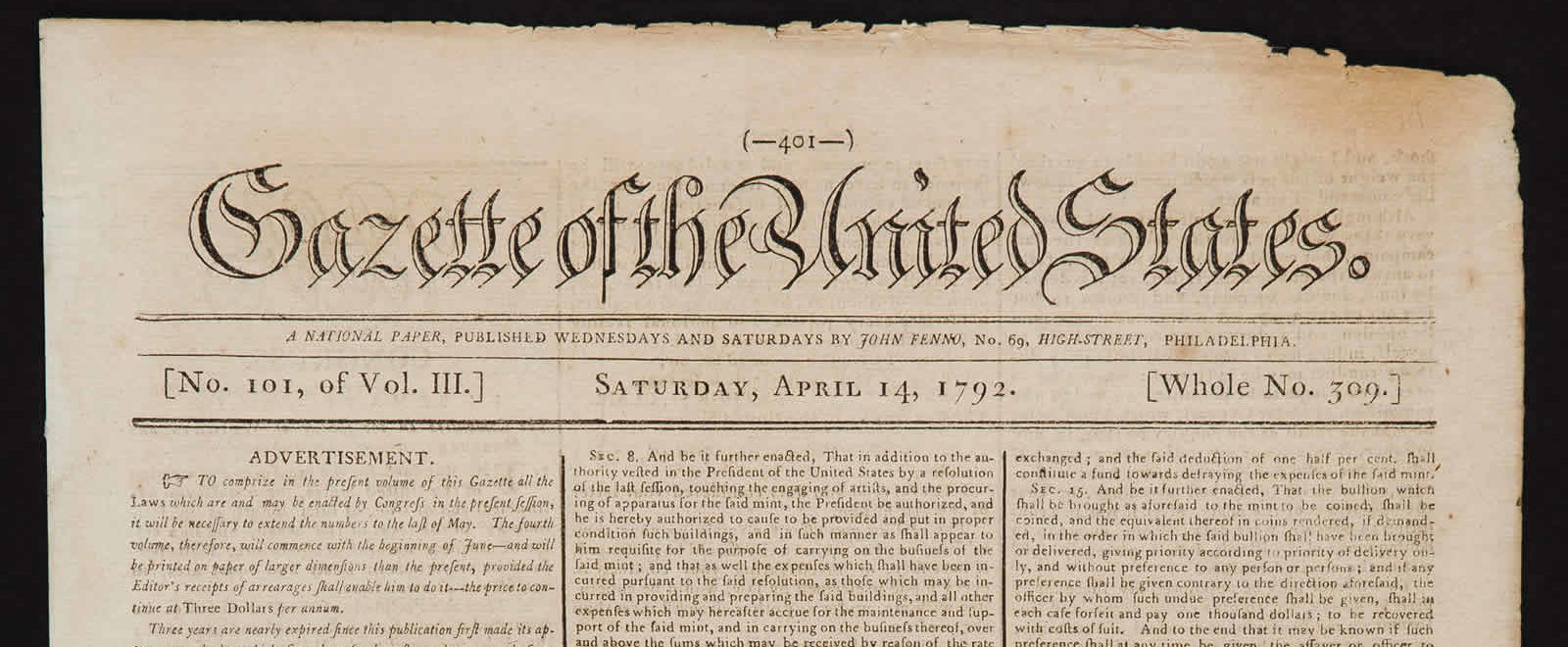1792 EDITION OF ‘GAZETTE OF THE UNITED STATES,’ WITH ITS REPRINTING OF MINT ACT, CONSIDERED A VITAL ARTIFACT AMONG COLLECTORS
By David Stone
No single document had a more profound effect on the monetary system of the United States than the Mint Act of 1792.
Having recently won its independence from England, after a hard-fought struggle, the new U.S. government was anxious to establish its sovereignty and confirm its status as an independent trading partner with the other nations of the world. Issuing its own money was an important step in accomplishing these goals. Accordingly, on April 2, 1792, Congress passed “an act establishing a mint, and regulating the Coins of the United States.” Some provisions of the act have been modified or superseded over the ensuing 224 years, but most of its specifications remained in force for decades, if not centuries, and it laid a solid foundation for everything that followed in the realm of U.S. coinage.
COINS
The act established a decimal-based monetary system, with the dollar as its basic unit of exchange. As specified by the act, the value of the U.S. dollar was equivalent to a Spanish milled dollar, the famous “piece of eight” of pirate stories. Fortunately, the decimal system made monetary calculations much simpler than they were under the Spanish system, where the basic unit was divided into eight parts, or the complicated system of the mother country, with 12 pence to the shilling, 20 shillings to the pound, etc. Most modern monetary systems are decimal-based, following the principles set down in the Mint Act, extending the influence of this landmark document far beyond the boundaries of this country.
By the 1790s, the financial system of the United States was in chaos. Most everyday transactions were settled using a motley collection of contemporary coins from foreign countries like England, Spain, France and Holland. Merchants would weigh each coin and assign it a value based on the intrinsic value of the metal it contained. Worn, leftover Colonial issues appeared frequently in such transactions and several states had issued their own limited coinage in the post-colonial era, under the Articles of Confederation. Paper money of dubious value circulated wherever it was accepted and the barter system still held sway in many rural areas. The Mint Act provided a standard, universally accepted medium of exchange, to simplify everyday transactions and greatly facilitate interstate commerce.
Informing the public about the new coinage was of the utmost importance to ensure its acceptance. To accomplish this, the contents of the Mint Act were widely publicized in newspapers throughout the country. These publications often acted as quasi-official organs of the various political parties of the time, providing a vehicle for advancing the party’s candidates and policies through their readership. One such publication was the Gazette of the United States, founded and edited by John Fenno as a semi-weekly newspaper in New York City, with its first edition appearing on April 15, 1789.
HAMILTON’S SUPPORT
The Gazette was the leading Federalist newspaper of the 1790s. It’s most enthusiastic supporter was Secretary of the Treasury Alexander Hamilton, who did much to organize its funding. He was also a frequent contributor of articles and essays, although many of his contributions were anonymous.
On Oct. 19, 1796, writing under his nom-de-plume Phocion, Hamilton accused his major political rival, Thomas Jefferson, of having an affair with one of his slaves. This piece was typical of the personal nature of partisan political attacks in the late 18th century. The Gazette followed the seat of the government when it moved to Philadelphia, relocating there in 1791. Fenno continued publishing the Gazette until his death in 1798. His son, John Ward Fenno, edited the paper for two years after his father’s death. The Gazette of the United States ceased publication in 1818.
Enlarge

Because of its proximity to the federal government, the Gazette of the United States was one of the first newspapers to disseminate the news of the Mint Act, and other important government decisions. As Fenno stated in his standard advertisement, subscribers could count on the “strictest punctuality on the part of the editor” in reporting the news through “a steady transmission of newspapers to all parts of the Union.”
In the April 14, 1792 edition of the Gazette, Fenno reprinted on the front page the entire contents of the recently approved Mint Act. This prominent front-page account has become one of the iconic images of American numismatics. Perhaps inspired by the Gazette’s coverage, the Boston-based Columbian Centinel reprinted the same article exactly one week later. The front page of the Centinel was later reproduced to form the cover of Pine Tree’s Early American Coppers Society Convention auction catalog, in February 1975.
Heritage Auctions President Greg Rohan recently was offered a copy of the famous April 14, 1792 edition of the Gazette of the United States by a business associate.
Copies of this important edition are seldom encountered today. Numismatic literature specialist David Fanning calls this paper “a great find” and relates that he has never handled a copy of this specific edition, though he has offered a few similar items. Recognizing the importance of this find, Rohan acquired this rare piece of numismatic ephemera for Heritage, with plans to preserve and display it at conventions and other gatherings for the enjoyment of all collectors and students of American numismatics.

DAVID STONE is a numismatic cataloger at Heritage Auctions who has written for The Numismatist and Coin World.

